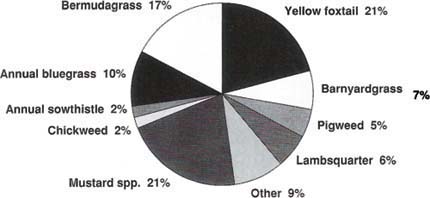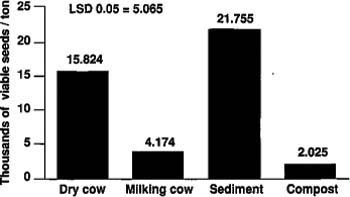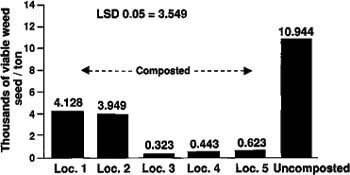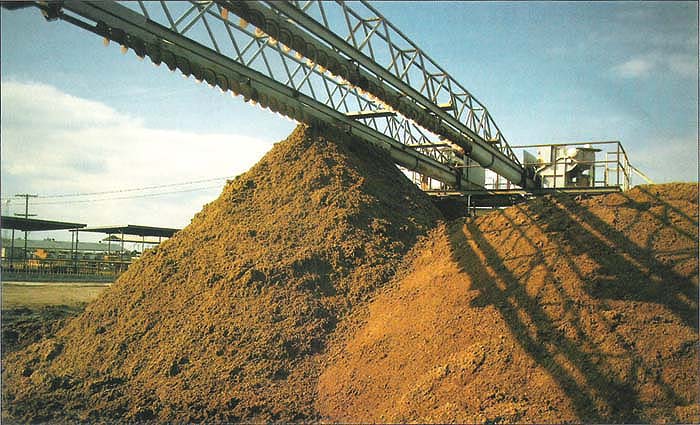All Issues
Weed seed in dairy manure depends on collection site
Publication Information
California Agriculture 46(3):31-32.
Published May 01, 1992
PDF | Citation | Permissions
Abstract
Dairy manure collected for 2 years from various sites in seven Central California dairies was found to contain viable weed seed. Weed seed Contamination Was most Severe when manure was taken from dry COW pens and liquid manure sedimentation handling facilities. Composting did not eliminate all viable weed seed.
Full text
Dairy manure has been an important soil amendment, particularly to less productive soils. It also has, however, a poor reputation among growers. Its use on farms has sometimes been correlated with weedier fields compared with farms not using it. The reasons for higher weed populations could be due to weeds in the manure, lack of effective composting, or contamination of the manure by windblown seeds from adjacent areas.
Tulare County has one of the largest dairy industries in the United States, and the manure produced as a by-product represents a major revenue source. It is spread on crop land within the region, but because of its reputation as a weed seed source, poultry manure or commercial fertilizers are often preferred as sources of nitrogen and phosphate.
Poultry manure is nearly weedfree, depending on how much soil and litter becomes mixed with it. Weeds are broken down by the grinding action of sand in the gizzard. In dairy animals, many seeds pass through the digestive system and remain viable. The digestive system may, in fact, loosen the hard seed coats of weeds, thus enhancing germination.
The objectives of our study of weed seeds in dairy manure were to learn which sites on the dairy contribute the most weed seed, what weed species are most prevalent and whether composting as practiced in commercial dairies effectively reduces weed seed viability.
Procedure
Manure samples were taken from six dairies in Tulare County and one in Kings County. Dairies selected were typical of those within the southern San Joaquin Valley. The dairies ranged in size from 350 to 1,500 cows and were categorized as traditional open corral with shades.
Seven sets of samples were taken from each dairy in 1988 and 1989. Samples were taken seasonally in April, July, October and December of 1988 and in April, July and December of 1989. Sites of sampling at each dairy included: dry cow (nonlactating) pens, milk-producing cow pens, compost piles, solid waste separators and sedimentation ponds. Each sample was a composite of five subsamples representative of the site and was 2.2 pounds in weight. Compost samples were taken from five of the dairies having manure piles 6 to 8 weeks old and were sampled from within the piles at least 2 feet deep.
To compare the relative content of viable weed seed in manure at the various sites of collection, we adhered to the following procedure. Manure samples were air dried and then gently pulverized. The manure was spread out over the surface of two 18- x 18-inch flats containing UC No. 2 potting mix (vermiculite, peat and lightly sprinkled two to three times a day thereafter, depending on moisture demand, to maintain surface moisture. Weed seed germination was accomplished in a greenhouse held at 20° to 25°C to assure germination of both cool- and warm-season weeds.
At 10 days, the first weed seedling counts were taken. The germinated weeds were removed, the flats were air dried for 1 week, and the surface was remixed and watered again for another 10 days, after which a second weed count was taken. Weeds were identified by species. Those that were difficult to identify were transplanted and grown to maturity for identification. It was recognized that only a fraction of the weeds present in the manure could be germinated and counted by this method due to dormancy, but relative comparisons could be made among the collection sites.
Results
The weed species most prevalent in manure samples from all of the dairies over the seven sampling times were grasses and broadleaf species (fig. 1). Broadleaf species included: pigweed (Amaranthus spp.), lambsquarter (Chenopodium album), sowthistle (Sonchus oleraceus), chickweed (Stellaria media) and such mustard species as shepherds purse (Capsella bursa-pastoris) and London rocket (Sisymbrium irio). Grassy weeds included yellow foxtail (Setaria glauca), bermudagrass (Cynodon dactylon), annual bluegrass (Poa annua) and barnyardgrass (Echinochloa crus-galli).
When different sites of manure collection were compared, samples differed in viable weed seed content. Manure taken from producing cow pens had notably fewer viable weed seeds than that collected from dry cow pens. Presumably, this was due to the lower quality of feed (weedier feed) fed the dry cows (fig. 2). Sediments from liquid manure-handling facilities (solid separator and sedimentation ponds) also contained a high viable weed count.
Composted manure was lowest in viable weed seed (fig. 2), but not entirely free of it. When manure is composted, weeds are killed by the heat generated the process. However, the effectiveness of composting varied (fig. 3). Location 1 had significantly more viable weed seeds than locations 3, 4 and 5. Location 2 had more weed seed than location 3. In no location was manure found to be completely free of viable weed seeds.
Conclusions
Dairy manure varied in weed seed content, depending on the site where it was sampled within the dairy. Weed seed amounts were highest in manure collected from dry cow pens and from the sediment of liquid manure-handling facilities. Seed content was lowest in manure collected from milking cow pens and when it had been composted. Composting manure might help assure farmers that they are not importing viable weed seeds with the manure they obtain from dairies, but as has been shown, the success of composting can vary. Most dairies in the region compost manure for 6 to 8 weeks. Probably a longer composting period, deeper piles and/or supplemental watering and turning of piles would improve composting reliability.








